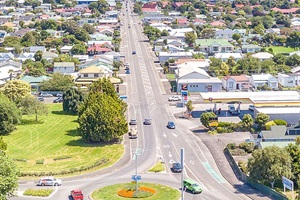Council plan to improve performance and address rates affordabiliity
Published on 26 October 2023

Whanganui Mayor Andrew Tripe says, along with councillors, he’s sent a clear message to Whanganui District Council staff that further cost savings and efficiencies – on top of those made at the start of his term as mayor – must be found to address rates affordability in Whanganui.
In response council chief executive David Langford has tabled a new organisational strategy for Whanganui District Council with the aim of making rates more affordable for the community while improving the council’s overall performance.
Mayor Andrew says that the whole country has experienced unacceptably high rates.
“The triple whammy of what I call the three I’s of high inflation, interest rates and insurance costs have seen unprecedentedly high rates increases with many councils issuing double-digit rates rises. Whanganui’s average increase of 7.9 percent is the highest for a long time and has come at a tough time for many in the community.
“All councils including ours continue to face inflationary pressures meaning we have to pay more to deliver services. Our first draft of budgets for the long-term plan have already indicated that next year’s rates increase could be more than 17 percent unless we take action to control costs.
“This level of increase is clearly unacceptable and isn’t going to be affordable for our community so it’s imperative the council finds significant cost savings and efficiencies as we work on delivering the services and facilities our community expects.
“The cost-of-living crisis isn’t over yet and many households have yet to feel its full effects. Quite a number of properties are on fixed term mortgages and these will expire in the next six to 12 months. When they do, households will really start to feel the impact of the recent increases in the official cash rate (OCR) interest rate.”
Mayor Andrew says he’s impressed with the new organisational strategy presented to elected members.
“I think this strategy’s going to be game-changing; I’ve been across many councils and government organisations and haven’t seen anything as comprehensive and high quality as this. It’s great to see our chief executive, David Langford, and the senior leadership team looking outside the box for ways to make rates more affordable and to improve council performance.”
The new organisational strategy follows a well-established business excellence model and sets out the council’s strategic priorities.
David Langford says it’s important for councillors and the community to see that council management has a plan for how it will lead the organisation and improve how it does its business.
“This not only covers things like process and system improvements – it also includes building the right kind of organisational culture and looking after our people. We need a strong ethos of accountability that supports the organisation to deliver excellence for our community. A big part of this is ensuring budgets are being managed in a disciplined and prudent way and that there’s a focus on continual improvement.”
He says cost-saving measures have been underway for some time.
“An example of this is our vacancy management programme where the leadership team reviews all vacancies before they are advertised – through this process, a number of non-critical roles have already been identified as savings and put on hold.
“We’ve also reviewed our vehicle fleet, identifying a number of under-utilised vehicles to be sold to shrink the size and cost of the fleet.”
David Langford says over the past few weeks the council’s senior leadership team has spoken to managers and staff and asked them to make a concerted effort to look for opportunities to increase efficiency and cut costs.
He says this is just the first stage – the senior leadership team has identified six significant ways to keep rates affordable, with initial targets set against each of them:
1. increasing non-rates revenue by $0.8M
2. securing alternative funding for $8M of council projects
3. finding a two percent efficiency saving ($1.5M after inflation adjustment) for year one of the long-term plan
4. implementing an ‘invest to save’ programme to deliver ongoing annual savings of one percent per annum
5. proposing $2M of service cuts or service level reductions
6. identifying $16M of assets that could be sold to repay debt.
Decisions on service level reductions or selling of assets will sit with councillors.
A review of council-controlled organisations (CCOs) is nearly complete and this is also expected to identify cost efficiencies.
Mayor Andrew says that for him, the cost of living pressures people are facing are always top of mind in his work at local and national level.
“Through the Future for Local Government review I’m part of a national group advocating for increased government funding allocated to councils so we have the resources to empower communities to get things done and build stronger regions into the future.”